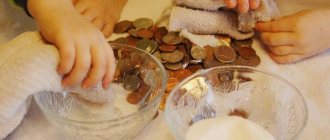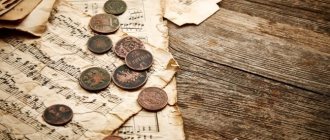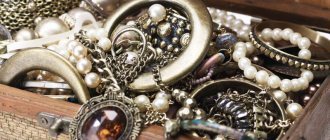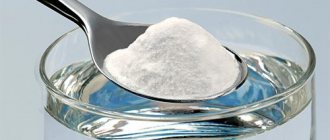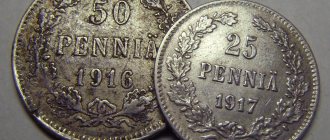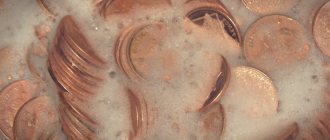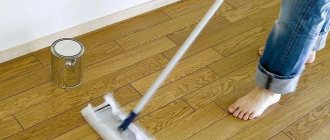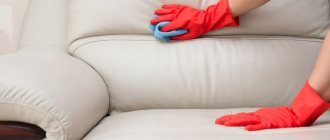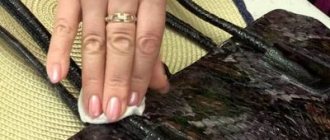Cleaning copper-nickel coins of the USSR (also known as cupronickel coins) is a constant headache for those who collect them; treasure hunters especially often face this problem. Sometimes even experienced collectors with experience do not really know how to clean such a coin in order to return it to its presentation. The fact is that this alloy is practically impossible to clean, if we talk about a good, high-quality result. And yet, it is possible to improve the appearance of coins made of a copper-nickel alloy; we will consider some relatively safe cleaning methods and its rules, with the caveat that in some cases it is better to leave everything as is.
Cleaning Nickel Coins by Electrolysis
For copper-nickel coins, when cleaning them by electrolysis, there is one special limitation: if you use graphite or stainless steel as the anode (“+”), then the surface of the coin will be well cleaned of oxides, but due to the presence of copper in the coin’s composition, it will acquire a characteristic copper tint. To eliminate this drawback, you can either use a nickel anode or carry out cleaning in two stages: the first is cleaning with a conventional anode and the second is covering the coin with a layer of nickel (the same cleaning but with a nickel anode).
| This ruble was covered with unpleasant red-brown oxides as a result of lying in the ground for several years. Using electrolysis cleaning, all oxides were removed, but the coin acquired an unnatural copper tint. To remove it, the coin was coated with nickel, for which another coin made of the same copper-nickel alloy was used as an anode. |
This cleaning method is not universal and the only one. On the contrary, while showing good results for coins with weak damage to the coin field, for heavily oxidized coins electrolysis opens up all cavities and other defects.
| These 20 kopecks from 1945 were heavily coated with copper and nickel oxides. As a result of cleaning by electrolysis, all oxides were removed, but deep cavities were opened. In addition, the color of the coin remained dark. |
Methods and procedure for carrying out the procedure
Strong vinegar solution
Carefully, so as not to damage the coin, immerse it in a solution of 9% vinegar. We do this with each coin separately. The initial time in the solution is 1-5 minutes. We take it out, clean it, evaluate the result.
If the coin is well preserved, the plaque can be easily removed. But if the condition is average or poor, then the plaque goes away slowly and the patina may also be removed and the design may suffer. Silver coins are more resistant to aggressive environments and last longer in solution.
Weak vinegar solution
It takes more time and acts more gently - a weak vinegar solution of 0.5-1% is used. The process must be monitored all the time and the result checked after 15 minutes. After 30 minutes, rinse under running water, brushing the product with a brush without pressure. If necessary, use a toothpick. Most often, the work takes 3-6 hours, but there are cases when the procedure takes longer.
You cannot leave the procedure uncontrolled - this can lead to disastrous results. If necessary, it is interrupted, the coin is washed and placed in a vessel with alcohol.
Soda with vinegar
Add 1 teaspoon of soda to the prepared vinegar solution. Then everything is thoroughly mixed, coins are placed in the prepared liquid. The procedure can be repeated several times until we get the desired result.
If you follow the instructions, we will achieve good results without the need for additional work on finishing, painting, or color leveling. There will even be a patina left.
Cleaning copper-nickel coins in acetic acid
Vinegar, as an aggressive medium, can be used to dissolve oxides on the surface of the coin. The disadvantage of this method of cleaning is damage to the surface of the coin; the photographs show that the entire coin after vinegar becomes littered with small cavities. In addition, the color of the coin changes from an unnatural red-brown to an equally unnatural pink.
| This coin was cleaned with vinegar in which it spent about a day. After removing it from the vinegar, it was cleaned with baking soda and a short-bristled toothbrush. For comparison, it was photographed next to a coin that was stored in good conditions and has an ideal appearance and does not require cleaning. |
Digestion
Cooking significantly speeds up the cleaning process. Typically a soda solution is used:
- Mix 1 tsp. soda and 100 ml of water.
- Bring the solution with the objects immersed in it to a boil.
- Hold the coins for about 5 minutes, then remove them with tweezers and evaluate the result. To do this, soak a piece of rag with vegetable oil and wipe the surface with it.
- If it doesn’t work the first time, you need to return the samples to the boiling solution and try again.
Advice: Practice on inexpensive items first, and then start cleaning more valuable ones.
Cleaning copper-nickel coins in vinegar and salt
This is, so to speak, an attempt to improve on the previous cleaning method; the main disadvantage of cleaning in vinegar is the appearance of a faint, but still noticeable pink coating of copper on the coin. Particular attention should be paid to the greenery on the coin; in areas of the copper-nickel coin on which there are dense green copper oxides, after such cleaning, pink copper spots will remain, which is not very beautiful. Thus, this method is applicable in cases where the coin is coated with uniform red nickel oxides.
The essence of the technology is that we add a teaspoon of ordinary table salt to 50 grams of 7% table vinegar and stir a little. It is difficult to dissolve such an amount of salt in such a small volume of vinegar, and this is not required; part of the salt should remain undissolved and lie at the bottom of the container in which cleaning is carried out. During such cleaning, coins should not be placed on their edges, but simply placed on the salt and turned over every 2-5 minutes. Depending on the degree of oxidation of the coin, it will take from 5 to 20 minutes.
| 20 kopecks 1933 before cleaning had dense green copper oxides on the surface, in place of which there were unattractive shiny pink copper spots. 15 kopecks of 1941 were cleaned in vinegar and salt, after cleaning the coin was ground in soda paste. The cleaning time for each coin was approximately 20 minutes. |
Rust color
Before deciding how to wash an old coin from rust, you need to decide on its color and intensity. The following patina is considered normal:
- on silver - the widest range of shades from yellowish to turquoise and even black;
- on copper - a dark brown, green or black film;
- on bronze - green, brown or dark gray;
- nickel - upon contact with moisture it acquires a gray color, and after interaction with PVC - a bluish or golden tint;
- on gold - on the highest standards, practically no oxide is formed, but when silver or copper is added, an orange color may appear.
It must be remembered that when storing coins in a sealed capsule, all conditions have been created to exclude the influence of third-party factors. There are sulfur ions that react with the surface of the metal, competing with oxygen, so the formation of rust stops. But such capsules have been made not so long ago, so this storage method was excluded for older specimens. Previously, the most gentle storage method was a mahogany case, so such metal money almost never needed significant cleaning.
A noble, uniform patina does not need to be cleaned, but if the oxide is thick, deep, causing too much discoloration or making it difficult to properly view relief details, then you need to decide how to wash the coins from rust.
Cleaning nickel coins with Trilon-B
Trilon-B is a fairly strong cleaning agent; it easily dissolves any oxides on the coin. And since copper-nickel coins do not have such a valuable patina as copper or silver coins, cleaning them with Trilon cannot harm them.
| 15 kopecks from 1953 were cleaned with Trilon-B solution. The coin was immersed in the solution for an hour, removed from the solution several times and rubbed with soda slurry. In order for both sides of the coin to be cleaned evenly, it is advisable to place the coin on its edge and lean it loosely against the wall of the container with the solution. |
Preparing for cleaning
Before cleaning, it is recommended to first boil the coins in an enamel bowl. It is important to dry the products thoroughly and make sure there is no moisture on them. To do this, lay them out on a dry napkin or paper towel. Before cleaning, it is better to test the selected product on other copper objects.
Strong chemical or mechanical effects can damage the surface, so all manipulations must be carried out carefully, making sure that your actions are correct. It is worth entrusting the cleaning of very rare and expensive coins to professionals. In other cases, you can safely remove plaque using improvised means.
Cleaning Soviet copper-nickel coins in hydrochloric acid (HCl)
Since it is quite problematic to buy pure hydrochloric acid in ordinary stores, for cleaning we used the “Toilet Duckling” plumbing cleaner, which contains the same hydrochloric acid.
| These 20 kopecks from 1931 were cleaned in a few hours in a solution of “Toilet Duckling” with water. The red coating was removed quite well, but in two places on the coin copper appeared at 8 o’clock and at 6 o’clock. Since the original color of the coin is gray or silver, the appearance of such pink copper shades does not look very nice. Also, a large number of shells and cavities opened up on the coin’s field, and part of the relief was also lost (before cleaning, even small details were clearly legible). |
How to clean with soda
A simple method that is suitable for most low-grade silver and copper coins. Soda is used in households to remove various contaminants, including from metal surfaces.
Cleaning steps using baking soda:
- Mix the powder with a small amount of water to make a paste.
- Apply the mixture to the coin.
- Using a thick cloth or brush (you can use a soft toothbrush), wipe the metal.
- Wipe the coin until both sides are completely clean.
A softer method that can be used on high-grade silver samples:
- Prepare a solution of 30 g of soda and 100 ml of water.
- Immerse the metal in it and wait a couple of hours.
- Rinse in clean water and dry.
Cleaning nickel coins with GOI paste
In general, the abrasive cleaning method is not desirable and is completely unacceptable for rare and valuable coins, but can be used to add shine to inexpensive coins from modern or not very old circulation. Such cleaning only has a negative effect on the value of the coins, so if the coins are ever sold, it is best not to clean them with GOI paste and other micro-abrasives. As a result of such cleaning, small details are erased and for coins of average or poor preservation this method is not applicable since the relief can be completely destroyed.
| To clean this coin, we used GOI paste + a felt attachment on an engraver (Dremel 4000, speed 10 - 15 thousand per minute). In 2 minutes, the oxides were removed from the coin and the patina began to shine like new. The shine is certainly beautiful, but not at all natural for a coin that is several decades old. |
| The method of cleaning with GOI paste is most suitable for bimetallic coins, since problems may arise with chemical cleaning due to the dual composition, but such problems cannot arise with micro-abrasive cleaning. The photo shows the result of cleaning bimetallic 10 rubles; next to it for comparison is a coin in approximately the same condition, but not cleaned. |
Causes of plaque on copper
Copper coins can become dull and develop a coating that completely hides the engraving. They usually take on a dark amber color. This occurs as a result of metal oxidation under the influence of air and moisture. In addition, copper, due to its structure, is considered not a very stable material.
Such a coating is usually called patina. It can be natural or artificial. The first type of patina is caused by the age and wear of the coin and its frequent use. In the world of numismatics, it is believed that the natural patina imparts special beauty and allows one to trace the history of a banknote.
Copper coins
Under the influence of an acidic environment, copper can acquire other shades. Green specimens indicate contact with sea water. Coins that have been in contact with the ground for a long time acquire a brown tint. A yellow coating indicates contact with lead objects. Therefore, the main criterion affecting the condition of a coin is the conditions of its storage.
Most of the copper money from the era of Tsarist Russia is in poor condition due to the cataclysms that the country has undergone over the past century. Some coins still remain in the ground, where no one has yet found them.
What is prohibited to do
In order not to spoil the collection material during cleaning, you must remember which techniques are prohibited:
- Abrasive components and aggressive components that can scratch the disc are taboo.
- The most effective methods are based on the use of chemically active agents. Before using them, you need to try on those specimens that are not valuable for the collection.
- Boiling is not used to remove rust, as this will lead to spoilage.
It is best to entrust the cleaning to professionals who specialize in this, because experience and knowledge are important for good results.

